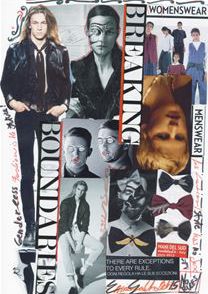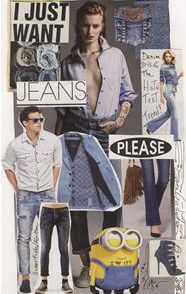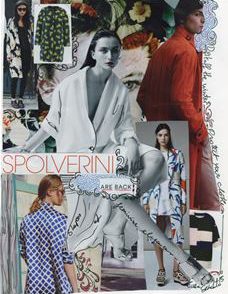Visiting the
marvelous exhibit entitled Salvador Dalì. Il
sogno si avvicina (‘The dream is
getting closer’) at Milan’s palazzo Reale (until January 30,
2011; www.mostradali.it),
I found myself reflecting on the essence of personal style and on a
time when clothes were vehicles for self expression. Especially
during its early years, the twentieth century, considered the century
of designers, generated a variety of styles that celebrated
eccentricity.
Indeed,
Italy’s Futurism of the early 1900s dictated actual rules about the
perfect look della donna futurista,
indicating what to choose in terms of fashion and, especially, what
to avoid. The concept was to communicate futuristic ideals such as
speed, movement and courage into day-to-day life, including, of
course, clothing. With its bright colours, extravagant shapes and
plays on volume and accessories, futuristic attire was extremely
daring and very different from the ‘ordinary’ clothes of the
time. Even make-up was re-invented for the woman of the future. It
was a philosophy expressed through style.
Subsequent decades saw the
marriage between art and fashion. Paris in the 20s and 30s was the
centre of expression. Exploring and experimenting with different
forms of expression was considered the key to successful living: the
individual found his strength in the continuous search for
self-expression. Being out of the ordinary in everyday life was a
concrete value, a way of escaping from the standard, boring
conformity of western society.
Fashion that embraced
these ideals commanded respect as an art form like painting,
sculpture or dance. Fashion designers such as Poiret, Chanel and Elsa
Schiaparelli collaborated with major artists. Mariano Fortuny,
creator of the unique Delphos Dress, was also a painter, theatre set
designer, inventor and curator of the Venice Biennial of Contemporary
Art. Like Jean Cocteau, Salvador Dalì was passionate about fashion
and worked with Schiaparelli (see Italian Sketches TF110), together
signing masterpieces like the Lobster Dress and the Tear Dress.
As I explored the exhibit
in Milan, what attracted my attention was Dalì’s personality: his
unique way of talking, his extravagant moustache. His entire look was
a window into his genius, a preview of his magic world. Likewise for
Schiaparelli. She chose the title Shocking Life for her
autobiography, about creating eccentric garments and living an
extraordinary, eccentric life. The pieces she created were not only
revolutionary, but also wearable. She de-emphasized traditional
femininity by avoiding the accentuation of womanly forms, aiming
rather at the expression of women’s individual characters and
personalities.
And this leads me to
wonder why eccentricity is no longer encouraged. We are urged daily,
through various forms of advertising, to fit into pre-prepared
categories, to join a pre-existing team. ‘Are you ethno-chic or
sporty-glam? Is your style girly or casual?’: these are questions
that come to mind. Fashion continuously declares seasonal trends and
must-have bags. The concept of what is ‘in’ and ‘out’ seems
to be so pervasive that we simply feel ‘out’ when we don’t
conform somehow.
Being well dressed does
not mean following a certain imposed style, but rather taking good
care of ourselves, wearing clothes that make us look good and
especially that make us feel great. As the world fashion market
chases trend after trend, more than ever it is paramount that one
clings to his or her ‘futuristic’ courage to think outside the
box and express eccentricity.
Florence is a small yet
international town. An enormous variety of people come from different
corners of the world to walk down its narrow streets. Perhaps it is
this range of looks and styles that contributes to the eclectic
nature of this city. Perhaps it is why one does not have the sense of
people being dressed identically. And here in Florence is it possible
to find out-of-the-ordinary pieces and unique accessories that
preserve an artistic value.
Right in front of the
Mercato del Porcellino is Guya, a small store full of surprises. The
exuberance of Vivienne Westwood, the shapes of Cappucci, the poetry
of Antonio Marras, the philosophy of Helmut Lang and much more is on
display. The clothing is pricy, but justifiably so. Another of my
favourites is Gerard on via Lambertesca 24r, and its sister store
Gerard Loft on via dei Pecori 34/36r, the latter offering more
casual, yet still very edgy collections.
Looking for crazy
custom-made shoes? Go to the famous Mondo Albion on via Nazionale.
Strolling around Santa Croce you’ll find a variety of designer
stores (see ‘Inside the designer zone,’ TF 76) that will have you
breathing some fresh fashion air. Also, the tiny 9 Rosso on Borgo San
Iacopo is full of vintage and retro bijoux.
This is only a short
list. Look around town, then look closer and then look even more. Do
not stop at the first chain store that catches your attention with
low (too low?) prices and too-loud music. The bottom line is that you
don’t need more clothes, you need your clothes. So get out there and create your own unique, eccentric and
extraordinary style!







